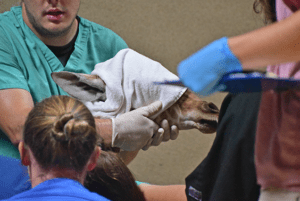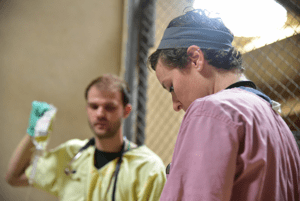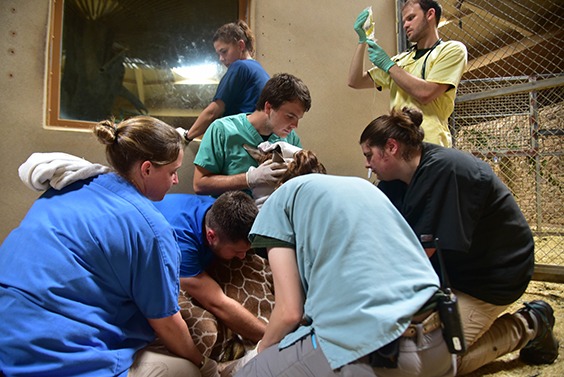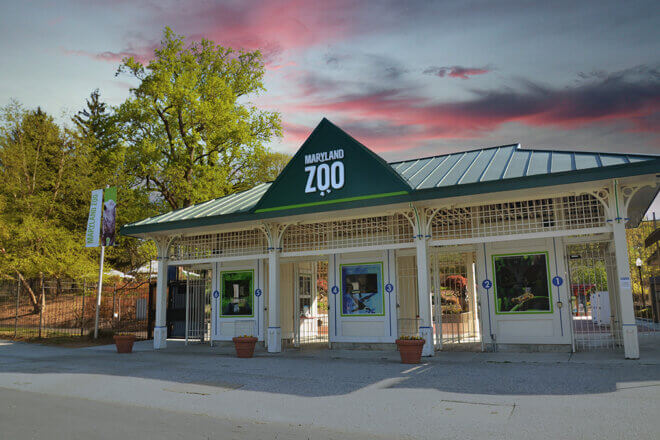The Maryland Zoo has partnered with the Columbus Zoo and Aquarium in Powell, Ohio, to provide additional support to the male giraffe calf born at The Maryland Zoo on Thursday, June 15. “The first 48 hours after birth is the critical time for giraffe calves to get the antibodies from mother’s milk, or in our case, the colostrum supplement. While markers in the blood were trending in the right direction, the calf still was not receiving enough of these infection-fighting antibodies from the supplemental feedings,” stated Erin Cantwell, mammal collection and conservation manager. “After the 48-hour window, the only other option for antibody transfer is a plasma transfusion from the blood of an adult giraffe. So, we decided to give another boost to his immune system with an intravenous transfusion of giraffe plasma, which was generously donated by the Columbus Zoo and Aquarium.”
“Maryland Zoo hospital keeper Kaitie Kessler drove to Morgantown, West Virginia, Friday night to meet Columbus Zoo Assistant Curator Shannon Morarity and Veterinarian Dr. Priya Bapodra-Villaverde. Kaitie picked up the giraffe plasma and drove it back to the Zoo on ice,” continued Cantwell. “On Saturday, our staff provided the calf the warmed plasma to help improve his immune system and strength.”
“The animal care team at the Columbus Zoo and Aquarium has done voluntary training with giraffes and other species to allow them to participate in their own care, such as receiving injections as well as drawing blood,” stated Dr. Priya Bapodra-Villaverde.“ The plasma is extracted from the blood with the assistance of The Ohio State University Veterinary Medical Center Animal Blood Bank/Transfusion Medicine Service.”

The Columbus Zoo and Aquarium, in collaboration with the Cheyenne Mountain Zoo, is establishing a national blood bank to supply plasma to any AZA-accredited facility that has a neonate that may need it. The primary focus is on species that are part of Species Survival Plans® (SSPs) including banked plasma from the Columbus Zoo’s tigers, elephants, polar bears, wildebeest and more.
“We are so grateful to the team at the Columbus Zoo for providing us with this potentially lifesaving plasma,” said Cantwell. “The teamwork to help this calf really extends out from our Zoo to the rest of the Association of Zoos & Aquariums (AZA) community and we really appreciate it.”
In addition to the plasma transfusion, the Zoo staff has begun to bottle feed the giraffe calf. “Normally a calf will nurse on mother’s milk for approximately six months,” said Cantwell. “Because this calf isn’t nursing, we made the decision to start to bottle feed him yesterday. Giraffe calves are notoriously difficult to bottle feed and it could take a week to get him on to the bottle according to other colleagues who have had to hand feed giraffe calves. We will also continue to supplement him with formula while he learns to bottle feed, so he will be getting the nutrition he needs.”

Mother and calf will remain behind the scenes in the Zoo’s Giraffe House, and the building will remain closed while staff continues to provide any necessary support to Kesi and her calf. The other giraffe may be outside and visible during different times of the day until the herd can be fully introduced to the new calf. “We remain optimistic that his health will improve; however, we are taking his condition seriously,” said Cantwell. “We really appreciate the good thoughts and well wishes from the public, as well as our zoo and aquarium colleagues, as we work to ensure that this little guy grows up to be a big, strong giraffe.”
The Maryland Zoo is a nonprofit organization that relies in large part on your support to fund critical animal care and conservation efforts for wildlife here and around the globe. Make a donation and help further the Zoo’s wild mission.






Share this article